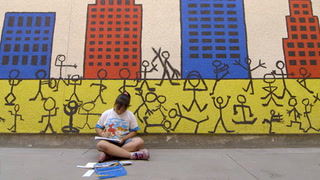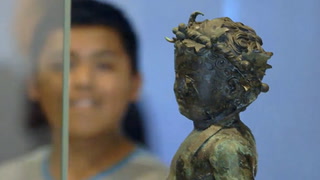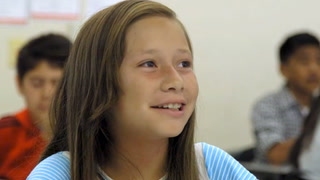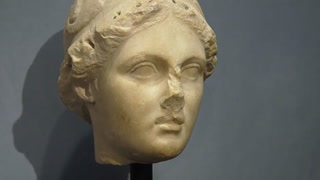Visiting a Museum Transcript
DAVID COOPER [sync]
00:00:08 Ladies and gentlemen, good morning.
CLASS
Good morning.
DAVID COOPER [sync]
00:00:11 We’re here at the Getty Villa today. Angelica, stand over here for me, please. Let’s pretend Angelica is a priceless object of art. Which isn’t that big a stretch.
00:00:23 [TITLE: Visiting a Museum]
[TITLE: A Classroom Strategy]
DAVID COOPER
00:00:26 Today I brought the students to the Getty Villa to put into practice what they’ve learned in the Greek God and Goddesses unit that I’m teaching in my Social Studies class. Because of the amount of poverty in my district the vast majority of the students I bring each year have never been to the Villa.
00:00:43 Many of them have never been to a museum. Bringing a group to the Getty Villa can help open their eyes to some of the possibilities that exist in the world.
DAVID COOPER [sync]
00:00:53 When we go to a museum, we have to be aware of where we are physically compared with something we’re looking at. When we go into the Museum, you’re going to see objects of art that you can actually walk all the way around and if you didn’t know any better, you could actually get up this close to.
00:01:12 But we don’t do that. If you can reach out and touch it, you’re too close. That doesn’t mean I want you walking around the galleries like this making sure you don’t touch anything.
DAVID COOPER
00:01:22 For teachers who are going to take their students to a museum, I think one of the most important things that you can go over with them is- is distance.
00:01:30 [TITLE: MUSEUM STRATEGY]
[TITLE: Teach students to maintain a safe distance from art objects]
DAVID COOPER
00:01:32 How close you should get to an art object. A lot of times pieces are just in the middle of the room or they’re on a wall and they’re not protected. Students need to understand that an appropriate distance is arm’s length so that they don’t get right- their face right up in- in an art object, which I’ve seen students of mine do.
DAVID COOPER [sync]
00:01:51 So, Tables Three and Six, come with me, please. The remaining tables are going to go with Ms. Cooper.
00:01:58 [TITLE: MUSEUM STRATEGY]
[TITLE: Divide large classes into smaller groups during field trips]
DAVID COOPER
00:02:02 I’m breaking the students up into two groups. We’ll have 12 students in one group that will be with me. The other group will have chaperones.
DAVID COOPER [sync]
00:02:10 Jason, what do I want you doing with your partner?
JASON
You want us to talk with- between our partners to- to help us identify the god or goddess.
DAVID COOPER [sync]
00:02:18 Absolutely.
DAVID COOPER
00:02:19 Giving the students an opportunity to collaborate either with a partner or with a group allows them to be focused on the work.
00:02:27 [TITLE: MUSEUM STRATEGY]
[TITLE: Pair students together to keep them on track]
DAVID COOPER
00:02:30 And it allows me a chance to circulate through the room and listen in to partnerships and hear their work and inject guidance where it’s necessary.
SASHA
00:02:39 What’s on the nose? It looks like something might have eaten away at it.
GLASSES
Yeah. Or maybe it fell and got damaged. Because it looks pretty old.
SASHA
00:02:46 It looks like something fell off right here.
DAVID COOPER [sync]
Remember, when we look at an object, we have to remember arm’s length. We don’t walk around with an arm out like this, but we can’t stand this close to an item.
00:02:57 We- To an object. We would hate to trip or touch something accidentally.
DAVID COOPER
00:03:02 Since the first time I brought a group to the Getty nine years ago, I have had an opportunity to watch the students transformed.
SASHA
00:03:09 What helps me identify this object as Aphrodite is her posture. It looks like she’s posing.
DAVID COOPER
00:03:15 I bring them to the Getty Villa and they get to see these objects in person and all of a sudden, a museum goes from being an intimidating place to some place that they feel that they belong and they can find meaning and purpose at. And it lights a spark in them.
00:03:33 ***FILE END***
















0 Comment